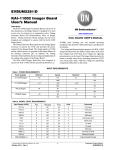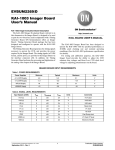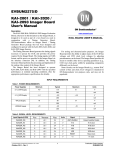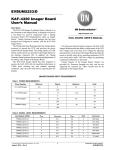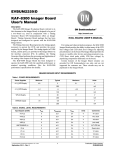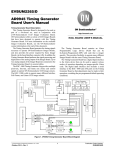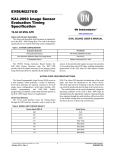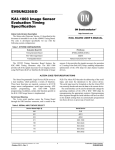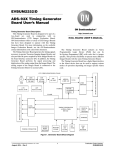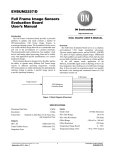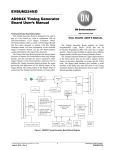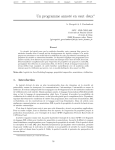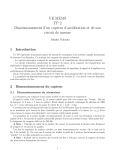Download KAI-4011 / KAI-4021 / KAI-04022 Imager Board User`s Manual
Transcript
EVBUM2279/D KAI-4011 / KAI-4021 / KAI-04022 Imager Board User's Manual Description www.onsemi.com The KAI−4011 / KAI−4021 / KAI−04022 Imager Evaluation Board, referred to in this document as the Imager Board, is designed to be used as part of a two−board set, used in conjunction with a Timing Generator Board. ON Semiconductor offers an Imager Board / Timing Generator Board package that has been designed and configured to operate with the KAI−4011 / KAI−4021 / KAI−04022 Image Sensors. The Timing Generator Board generates the timing signals necessary to operate the CCD, and provides the power required by the Imager Board. The timing signals, in LVDS format, and the power, are provided to the Imager Board via the interface connector (J1). In addition, the Timing Generator Board performs the processing and digitization of the analog video output of the Imager Board. The KAI−4011 / KAI−4021 / KAI−04022 Imager Board has been designed to operate the KAI−4011 / KAI−4021 / EVAL BOARD USER’S MANUAL KAI−04022 CCDs with the specified performance at 40 MHz pixel clocking rate and nominal operating conditions. (See the KAI−4011 / KAI−4021 / KAI−04022 performance specifications for details). For testing and characterization purposes, the KAI−4011 / KAI−4021 / KAI−04022 Imager board provides the ability to adjust many of the CCD bias voltages and CCD clock level voltages by adjusting potentiometers on the board. The Imager Board provides the means to modify other device operating parameters (CCD reset clock pulse width, VSS bias voltage) by populating components differently on the board. INPUT REQUIREMENTS Table 1. POWER REQUIREMENTS Power Supplies Minimum Typical Maximum Units +5 V_MTR Supply 4.9 5.0 5.1 V −5 V_MTR Supply −5.1 1400 mA −5.0 −4.9 V 200 18 VPLUS Supply mA 20 21 V 175 −21 VMINUS Supply mA −20 −18 V 150 mA Table 2. SIGNAL LEVEL REQUIREMENTS Input Signals (LVDS) Vmin Vthreshold Vmax Units Comments H1A (±) 0 ±0.1 2.4 V H1A clock H1B (±) 0 ±0.1 2.4 V H1B clock H2A (±) 0 ±0.1 2.4 V H2A clock H2B (±) 0 ±0.1 2.4 V H2B clock FDG 0 ±0.1 2.4 V Fast Dump clock R (±) 0 ±0.1 2.4 V Reset clock V1 (±) 0 ±0.1 2.4 V V1 clock V2 (±) 0 ±0.1 2.4 V V2 clock © Semiconductor Components Industries, LLC, 2014 October, 2014 − Rev. 2 1 Publication Order Number: EVBUM2279/D EVBUM2279/D Table 2. SIGNAL LEVEL REQUIREMENTS Input Signals (LVDS) Vmin Vthreshold Vmax Units Comments V2B (±) 0 ±0.1 2.4 V V2B clock V3RD (±) 0 ±0.1 2.4 V V2 Clock 3rd level VES (±) 0 ±0.1 2.4 V Electronic Shutter AMP_ENABLE (±) 0 ±0.1 2.4 V Output Amplifier Enable ARCHITECTURE OVERVIEW frame to transfer the charge from the photodiodes to the vertical CCDs. The following sections describe the functional blocks of the KAI−4011 / KAI−4021 / KAI−04022 Imager Board (Refer to Figure 1). CCD FDG Driver The Fast Dump Gate (FDG) driver is a transistor that will switch the voltage on the FDG pin of the CCD from FDG_LOW to FDG_HIGH during Fast Dump Gate operation. When not in operation, or when the Fast Dump Gate feature is not being utilized, the FDG pin of the CCD is held at FDG_LOW. The FDG_HIGH and FDG_LOW voltage levels of the FDG driver are set by resistor divider circuits, and are buffered by operational amplifiers configured as voltage followers. Power Filtering and Regulation Power is supplied to the Imager Board via the J1 interface connector. The power supplies are de−coupled and filtered with ferrite beads and capacitors to suppress noise. Voltage regulators are used to create the +15 V and –15 V supplies from the VPLUS and VMINUS supplies. LVDS Receivers / TTL Buffers LVDS timing signals are input to the Imager Board via the J1 interface connector. These signals are shifted to TTL levels before being sent to the CCD clock drivers. VES Circuit The pixel rate CCD clock drivers utilize two fast switching transistors that are designed to translate TTL−level input clock signals to the voltage levels required by the CCD. The high level and low level of the CCD clocks are set by potentiometers. The quiescent CCD substrate voltage (VSUB) is set by a potentiometer. For electronic shutter operation, the VES signal drives a transistor amplifier circuit that AC−couples the voltage difference between the VPLUS and VMINUS supplies onto the Substrate voltage. This creates the necessary potential to clear all charge from the photodiodes, thereby acting as an electronic shutter to control exposure. Reset Clock One−Shot (U15; not populated) CCD Bias Voltages CCD Pixel−Rate Clock Drivers (H1, H2 & Reset Clocks) The pulse width of the RESET_CCD clock used to be set by a programmable One−Shot. The One−Shot was configured to provide a RESET_CCD clock signal with a pulse width from 5 ns to 15 ns. Now, the pulse width control functionality is provided by the KSC−1000 Timing Generator Board, and the one−shot has been bypassed by removing U15 and inserting a shorting resistor on pads 1 and 2 of U15. The CCD bias voltages are set by potentiometers, buffered by operational amplifiers configured as voltage followers. The bias voltages are de−coupled at the CCD pin. CCD Image Sensor This evaluation board supports the KAI−4021, and KAI−04022 Image Sensors. KAI−4011, Emitter−Follower The VOUT_CCD signals are buffered using bipolar junction transistors in the emitter−follower configuration. These circuits also provide the necessary 5 mA current sink for the CCD output circuits. CCD VCLK Drivers The vertical clock (VCLK) drivers consist of MOSFET driver IC’s. These drivers are designed to translate the TTL−level clock signals to the voltage levels required by the CCD. The high, middle, and low voltage levels of the vertical clocks are set by potentiometers buffered by operational amplifiers configured as voltage followers. The current sources for these voltage levels are high current (up to 600 mA) transistors. The V2_CCD high level clock voltage is switched from V_MID to V_HIGH once per Line Drivers The buffered VOUT_CCD signals are AC−coupled and driven from the Imager Board by operational amplifiers in a non−inverting configuration. The operational amplifiers are configured to have a gain of 2, to correctly drive 75 W video coaxial cabling from the SMB connectors. http://onsemi.com 2 EVBUM2279/D OPERATIONAL SETTINGS were correct at the time of this document’s publication, but may be subject to change; refer to the KAI−4011 / KAI−4021 / KAI−04022 device specification. The Imager board is configured to operate the KAI−4011 / KAI−4021 / KAI−04022 Image Sensors under the following operating conditions: DC Bias Voltages The following voltages are fixed, or adjusted with a potentiometer as noted. The nominal values listed in Table 3 Table 3. DC BIAS VOLTAGES Description Symbol Min Nominal Max Units Left Output Amplifier Supply VDDL 15.0 V Right Output Amplifier Supply VDDR 15.0 V Reset Drain VRD ESD Protection 6.7 12.0 ESD 13.5 Potentiometer 1 V −9.0 Notes R23 3 V Substrate VSUB 8.5 TBD 15.0 V R18 3 Output Gate Left VOGL −7.5 −3.5 −0.4 V R11 2, 3 Output Gate Right VOGR −7.5 −3.5 −0.4 V R7 2, 3 1. If the CCD is to be operated in single output mode only (VOUT_LEFT) the unused output amplifier supply can be tied to ground to conserve power by not populating R71, R72 and C76 and by replacing C75 with a 0 W resistor. 2. The Output Gate signals VOGL and VOGR may be controlled independently, or, by installing R28 and R33 and removing R29, may be set to the same potential, controlled by R11. 3. The Min and Max voltages in the table indicate the imager board potentiometer adjustable voltage range. These values may exceed the specified CCD operating conditions. See the KAI−4011 / KAI−4021 / KAI−04022 device specification for details. Clock Voltages Table 4 were correct at the time of this document’s publication, but may be subject to change; refer to the KAI−4011 / KAI−4021 /KAI−04022 device specification. The following clock voltage levels are fixed, or adjusted with a potentiometer as noted. The nominal values listed in Table 4. CLOCK VOLTAGES Description Symbol Level Min Nom Max Unit Potentiometer Notes Horizontal CCD Clock Hxx_CCD Low −7.5 −4.5 −0.8 V R147 4 High 0.4 0.5 7.5 V R127 5 Vx_CCD Low −14.0 −9.0 −1.0 V R40 6 Vx_CCD Mid −2.5 −0.0 −0.0 V R66 7 V2_CCD High 4.0 9.0 11.0 V R48 Low −7.0 −3.5 −1.0 V R20 High 1.0 5.0 7.0 V R19 Vertical CCD Clock Reset Clock Fast Dump Clock 4. 5. 6. 7. 8. RESET_CCD FDG_CCD Low −9.0 V High 5.0 V The H1A_CCD, H1B_CCD, H2A_CCD, and H2B_CCD low levels are controlled by the same potentiometer (R147). The H1A_CCD, H1B_CCD, H2A_CCD, and H2B_CCD high levels are controlled by the same potentiometer (R127). V1_CCD and V2_CCD low levels are controlled by the same potentiometer (R40). V1_CCD and V2_CCD mid levels are controlled by the same potentiometer (R66). FDG is used to flush the device when operated in Still Mode. http://onsemi.com 3 8 EVBUM2279/D BLOCK DIAGRAM AND PERFORMANCE DATA J3 SMB J2 SMB LINE DRIVER EMITTER FOLLOWER EMITTER FOLLOWER V3RD DRIVER V2 DRIVER LINE DRIVER (optional) VOUT LEFT VOUT RIGHT CCD SENSOR RCLK DRIVER RCLK 1 SHOT FDG CKT V1 DRIVER VES CKT H1A DRIVER H2A DRIVER H1B DRIVER H2B DRIVER LVDS TO TTL BUFFERS +15 V REGULATOR LVDS RECEIVERS −15 V REGULATOR J1 BOARD INTERFACE CONNECTOR Figure 1. KAI−4011 / KAI−4021 / KAI−04022 Imager Board Block Diagram LINEARITY SIGNAL MEAN (ELECTRONS) 100000 10000 1000 MEASURED 100 FIT 10 %DEVIATION FROM FIT 1 0.1 0.01 0.1 1 10 INTEGRATION TIME (SECONDS) Figure 2. Measured Performance − Linearity http://onsemi.com 4 EVBUM2279/D Photon Transfer 100 Noise (A/D counts) Slope = el/Adu = 9.29 electrons Noise floor = 3.65 counts (33.9 electrons) 10 LVSAT = 30220 electrons VSAT = 32980 electrons 1 10 100 1000 10000 100000 Signal Mean (Electrons) Figure 3. Measured Performance − Dynamic Range and Noise Floor http://onsemi.com 5 EVBUM2279/D CONNECTOR ASSIGNMENTS AND PINOUTS SMB Connectors J2 and J3 75 W should be used to connect the imager board to the Timing Generator Board to match the series and terminating resistors used on these boards. The emitter−follower buffered CCD_VOUT signals are driven from the Imager Board via the SMB connectors J2 and J3. Coaxial cable with a characteristic impedance of Table 5. J1 INTERFACE CONNECTOR PIN ASSIGNMENTS Pin Signal Pin Signal 1 N.C. 2 N.C. 3 AGND 4 AGND 5 VES+ 6 VES− 7 AGND 8 AGND 9 FDG+ 10 FDG− 11 AGND 12 AGND 13 V3RD+ 14 V3RD− 15 AGND 16 AGND 17 V2B+ 18 V2B− 19 AGND 20 AGND 21 V2+ 22 V2− 23 AGND 24 AGND 25 V1+ 26 V1− 27 AGND 28 AGND 29 R+ 30 R− 31 AGND 32 AGND 33 H2B+ 34 H2B− 35 AGND 36 AGND 37 H2A+ 38 H2A− 39 AGND 40 AGND 41 H1B+ 42 H1B− 43 AGND 44 AGND 45 H1A+ 46 H1A− 47 N.C. 48 N.C. 49 AGND 50 AGND 51 N.C. 52 N.C. 53 VMINUS_MTR 54 VMINUS_MTR 55 N.C. 56 N.C. 57 AGND 58 AGND 59 AMP_ENABLE+ 60 AMP_ENABLE− 61 −5 V_MTR 62 −5 V_MTR 63 N.C. 64 N.C. 65 AGND 66 AGND 67 N.C. 68 N.C. 69 +5 V_MTR 70 +5 V_MTR 71 N.C. 72 N.C. 73 AGND 74 AGND 75 N.C. 76 N.C. 77 VPLUS_MTR 78 VPLUS_MTR 79 N.C. 80 N.C. http://onsemi.com 6 EVBUM2279/D Warnings and Advisories Ordering Information ON Semiconductor is not responsible for customer damage to the Imager Board or Imager Board electronics. The customer assumes responsibility and care must be taken when probing, modifying, or integrating the ON Semiconductor Evaluation Board Kits. When programming the Timing Board, the Imager Board must be disconnected from the Timing Board before power is applied. If the Imager Board is connected to the Timing Board during the reprogramming of the Altera PLD, damage to the Imager Board will occur. Purchasers of an Evaluation Board Kit may, at their discretion, make changes to the Timing Generator Board firmware. ON Semiconductor can only support firmware developed by, and supplied by, ON Semiconductor. Changes to the firmware are at the risk of the customer. Please address all inquiries and purchase orders to: Truesense Imaging, Inc. 1964 Lake Avenue Rochester, New York 14615 Phone: (585) 784−5500 E−mail: [email protected] ON Semiconductor reserves the right to change any information contained herein without notice. All information furnished by ON Semiconductor is believed to be accurate. ON Semiconductor and the are registered trademarks of Semiconductor Components Industries, LLC (SCILLC) or its subsidiaries in the United States and/or other countries. SCILLC owns the rights to a number of patents, trademarks, copyrights, trade secrets, and other intellectual property. A listing of SCILLC’s product/patent coverage may be accessed at www.onsemi.com/site/pdf/Patent−Marking.pdf. SCILLC reserves the right to make changes without further notice to any products herein. SCILLC makes no warranty, representation or guarantee regarding the suitability of its products for any particular purpose, nor does SCILLC assume any liability arising out of the application or use of any product or circuit, and specifically disclaims any and all liability, including without limitation special, consequential or incidental damages. “Typical” parameters which may be provided in SCILLC data sheets and/or specifications can and do vary in different applications and actual performance may vary over time. All operating parameters, including “Typicals” must be validated for each customer application by customer’s technical experts. SCILLC does not convey any license under its patent rights nor the rights of others. SCILLC products are not designed, intended, or authorized for use as components in systems intended for surgical implant into the body, or other applications intended to support or sustain life, or for any other application in which the failure of the SCILLC product could create a situation where personal injury or death may occur. Should Buyer purchase or use SCILLC products for any such unintended or unauthorized application, Buyer shall indemnify and hold SCILLC and its officers, employees, subsidiaries, affiliates, and distributors harmless against all claims, costs, damages, and expenses, and reasonable attorney fees arising out of, directly or indirectly, any claim of personal injury or death associated with such unintended or unauthorized use, even if such claim alleges that SCILLC was negligent regarding the design or manufacture of the part. SCILLC is an Equal Opportunity/Affirmative Action Employer. This literature is subject to all applicable copyright laws and is not for resale in any manner. PUBLICATION ORDERING INFORMATION LITERATURE FULFILLMENT: Literature Distribution Center for ON Semiconductor P.O. Box 5163, Denver, Colorado 80217 USA Phone: 303−675−2175 or 800−344−3860 Toll Free USA/Canada Fax: 303−675−2176 or 800−344−3867 Toll Free USA/Canada Email: [email protected] N. American Technical Support: 800−282−9855 Toll Free USA/Canada Europe, Middle East and Africa Technical Support: Phone: 421 33 790 2910 Japan Customer Focus Center Phone: 81−3−5817−1050 http://onsemi.com 7 ON Semiconductor Website: www.onsemi.com Order Literature: http://www.onsemi.com/orderlit For additional information, please contact your local Sales Representative EVBUM2279/D







